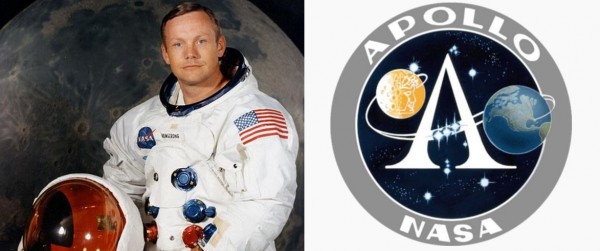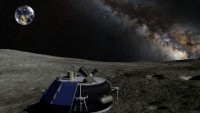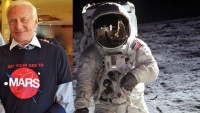Deep Space Radiation is Killing-off Apollo Astronauts; Raises Red Flag for Missions to Mars
| Arthur Dominic Villasanta | | Jul 29, 2016 04:47 AM EDT |
(Photo : NASA) The death of Neil Armstrong, the first human to walk on the Moon on July 21, 1969, was linked to coronary artery disease. Insignia of the Apollo Program.
A disturbing new study that found American astronauts of the Apollo Program from 1961 to 1972 are more prone to heart attack deaths illustrates the dangers of deep space radiation. This is the first study looking at the mortality of Apollo astronauts.
The men of the Apollo Program that landed the first humans on the Moon in 1969 are experiencing higher rates of cardiovascular-related deaths thought to be caused by their exposure to deep space radiation, said the study conducted by Professor Michael Delp, Florida State University Dean of the College of Human Sciences.
Like Us on Facebook
The Apollo program consisted of 11 manned flights into space between 1968 and 1972. Nine of those flew beyond Earth's orbit into deep space. Twelve Americans landed on the Moon with 12 others having either orbited the Moon or journeyed into deep space.
In a new paper in Scientific Reports, Delp found out the astronauts who traveled into deep space as part of the Apollo Moon missions were exposed to levels of galactic cosmic radiation not experienced by any other astronauts or Russian cosmonauts. That exposure is now manifesting itself as cardiovascular problems.
"We know very little about the effects of deep space radiation on human health, particularly on the cardiovascular system," said Delp. "This gives us the first glimpse into its adverse effects on humans."
Delp found that 43 percent of deceased Apollo astronauts died from a cardiovascular problem. That's four to five times higher than non-flight astronauts and astronauts who have traveled in low Earth orbit.
Of the 24 men who flew into deep space on the Apollo lunar missions, eight have died and seven were included in the study. The eighth -- Edgar Mitchell -- died after the data analysis was completed.
Delp and his colleagues also exposed mice to the type of radiation that Apollo astronauts would have experienced. After six months -- the equivalent of 20 human years -- the mice demonstrated an impairment of arteries that is known to lead to the development of atherosclerotic cardiovascular disease in humans.
"What the mouse data show is that deep space radiation is harmful to vascular health," said Delp.
Delp is working with NASA to conduct additional studies on the Apollo astronauts regarding their cardiovascular health.
Delp's research is of special interest now as the United States and other nations, plus private organizations, make plans for deep space travel to the Moon, the asteroids, Mars and its moons.
NASA has unveiled plans for U.S. orbital missions around the moon from 2020 to 2030 in preparation for a manned flight to Mars. Russia, China and the European Space Agency are all looking at lunar missions. And SpaceX, owned by Elon Musk, has proposed landing humans on Mars by 2026.
As a group, astronauts are highly educated and have access to top medical care, meaning their healthcare outcomes are generally better than the general population. But the group of men in the Apollo program experienced different environmental conditions than anyone else in the world when they traveled into deep space.
Tagsastronauts, Apollo Program, moon, cardiovascular-related deaths, Professor Michael Delp
©2015 Chinatopix All rights reserved. Do not reproduce without permission
EDITOR'S PICKS
-

Did the Trump administration just announce plans for a trade war with ‘hostile’ China and Russia?
-

US Senate passes Taiwan travel bill slammed by China
-

As Yan Sihong’s family grieves, here are other Chinese students who went missing abroad. Some have never been found
-

Beijing blasts Western critics who ‘smear China’ with the term sharp power
-

China Envoy Seeks to Defuse Tensions With U.S. as a Trade War Brews
-

Singapore's Deputy PM Provides Bitcoin Vote of Confidence Amid China's Blanket Bans
-

China warns investors over risks in overseas virtual currency trading
-

Chinese government most trustworthy: survey
-

Kashima Antlers On Course For Back-To-Back Titles
MOST POPULAR
LATEST NEWS
Zhou Yongkang: China's Former Security Chief Sentenced to Life in Prison

China's former Chief of the Ministry of Public Security, Zhou Yongkang, has been given a life sentence after he was found guilty of abusing his office, bribery and deliberately ... Full Article
TRENDING STORY

China Pork Prices Expected to Stabilize As The Supplies Recover

Elephone P9000 Smartphone is now on Sale on Amazon India

There's a Big Chance Cliffhangers Won't Still Be Resolved When Grey's Anatomy Season 13 Returns

Supreme Court Ruled on Samsung vs Apple Dispute for Patent Infringement

Microsoft Surface Pro 5 Rumors and Release Date: What is the Latest?













